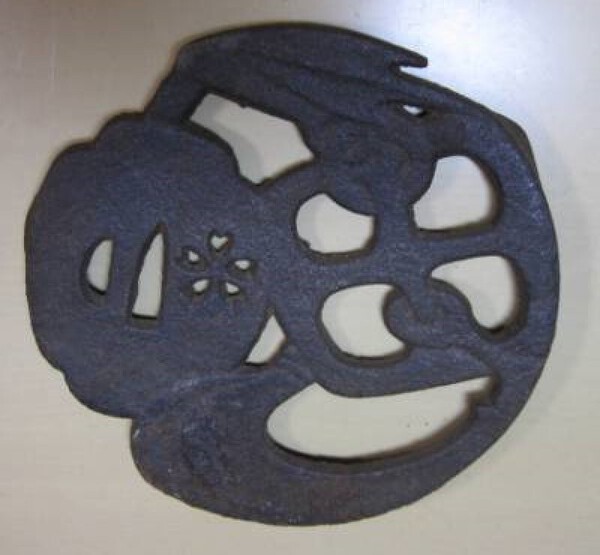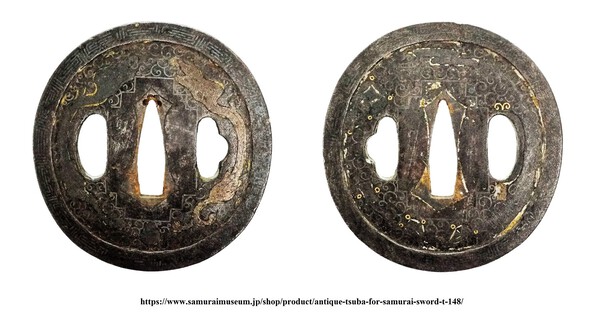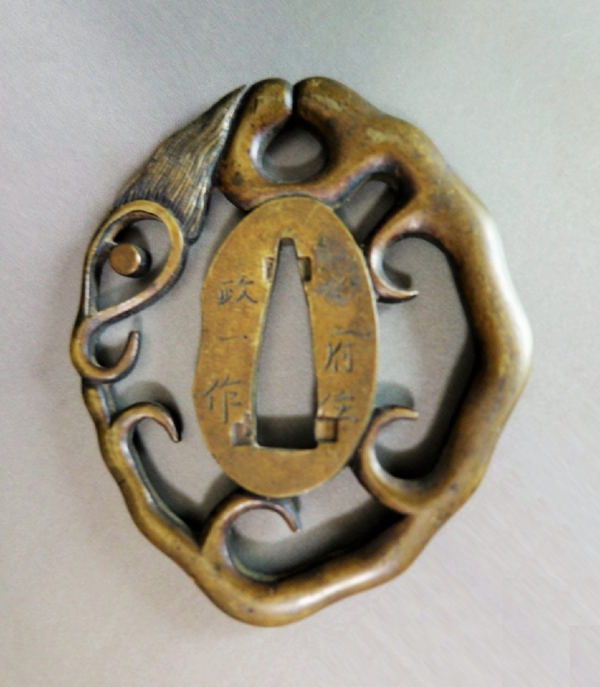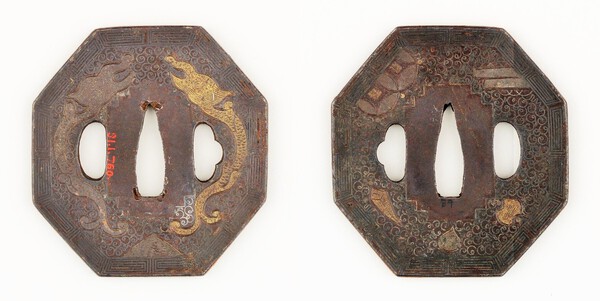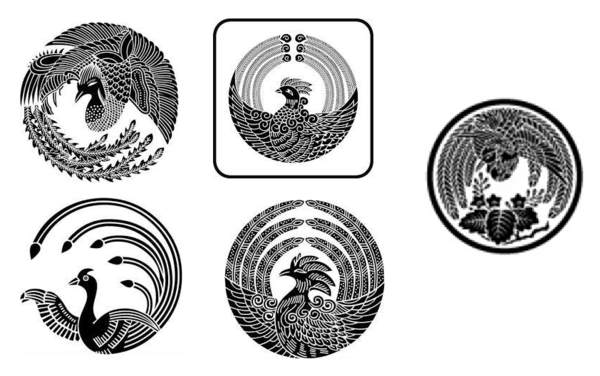-
Posts
3,413 -
Joined
-
Last visited
-
Days Won
90
Content Type
Profiles
Forums
Events
Store
Downloads
Gallery
Everything posted by Spartancrest
-
Ken, not a salamander - more likely a rain dragon 'Ameryu' [bifurcated tail tends to be a design feature of rain dragons, though not all show this] There are examples here on the NMB link of other Wan-gata guards. Particularly about half way through, with one guard of a very similar shape and a 'Greek' fret pattern matching your rim. [described later as a cookie cutter - but for my two cents worth, more like a bottle cap] Another https://www.pinterest.com.au/pin/292593307040614207/ unfortunately the image no longer links to the original site. The two identical sized udenuki-ana may reflect the piece was made in China [where the function was not known] or are a design of water droplets rather than intended for a sword strap/cord. [Yes the holes are very dirty] Sorry but I can't attribute a particular school or maker.
-
Can anyone think why you would disassemble a Natsuo koshirae - it seems to me the parts are still less than the whole?
-
Has everyone missed that this guard has been mounted? How many Natsuo guards were actually fitted to a blade - does anyone know? I can't help wondering what sort of blade would have been of appropriate quality to be fitted with a top quality Natsuo piece [which most agree this is not]?
-
Patrick, what is the other side like?
-
Hi Alban I know I have already sent you the image of the Anchor for sale on ebay but that guard has a 'utsushi' or larger companion in the Princeton University Art Museum. Also a sukashi anchor, also from that collection, you might like to add to your records. y1930-65 = 83 mm x 77 mm x 7 mm y1930-63 = 71 mm x 67 mm x 5 mm
-
There are also some huge wall hanger decoration 'tsuba'. I have turned mine into a garden ornament. It is over 30cm tall, also a wall plaque 10 cm I believe these large 'wall hanger' tsuba are made as home decoration for certain festivals or celebrations, I have seen plain 'iron' [steel] and also copper or gilding over iron versions.
-
Are Shibayama truly tsuba? I love the workmanship but are they truly tsuba or just tourist ware? They could never serve the function they are imitating - so are they outside the realm of tosogu and more in the way of 'decorative foreign exchange'? https://www.jauce.com/auction/q1002008505 [There have been some problems lately with links to Jauce. - I am uncertain why.]
-
Bruno, If I owned it I wouldn't care who made it - I would be thankful just to have it! Beautiful piece!! [But I wish you good luck with your search]
-
Alban I have an image from an article published by the Museum of Fine Arts, Boston in 1912 of a Choshu school guard from the 18th century.
-
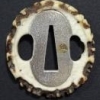
Age or Corrosion on Tsuba? How to recognize wear.
Spartancrest replied to 10thRoyal's topic in Tosogu
Michael I do hope we don't lose the practical nihonto/tosogu - the pretty stuff won't reflect the truth and we will be the worse without it. The duality of function and beauty can't really exist without each other. Who can even define what beauty is and what is worth saving? -

Age or Corrosion on Tsuba? How to recognize wear.
Spartancrest replied to 10thRoyal's topic in Tosogu
Michael it looks much better with the darker image. I have the same problem with some museum examples that I look at - either too dark to see any detail or too washed out to give a proper image [sometimes you can't win] I rather like Tanto guards, they somehow seem a neglected part of collecting - size is not everything! The other guards are [sorry] pretty run of the mill, and utilitarian - made for use rather than decorative - the dragon I think is cast, the mei look overly wide with a curved indent not like you get with a sharp chisel. There are two lines which shouldn't be where they are and what looks like a rounded over edge to the nakago-ana. [could be wrong it wouldn't be the first time!] -

Age or Corrosion on Tsuba? How to recognize wear.
Spartancrest replied to 10thRoyal's topic in Tosogu
Just a guess but it looks like it is corroded more on one side, pointing to it being stored in a not very dry container/or even under a house. Then over cleaned, there looks to be no 'patina' left [unless the lighting is harsh?] The nakago-ana looks recently cleaned might I say filed? Heianjo style with a slightly raised rim, Kiku mon [yours originally, were better defined than the example image below] and Karakusa scrolls. I think it would have been a very attractive piece and from my experience there don't seem to be many Tanto sized pieces out there (?), but as Indiana Jones said "It's not the age - it's the mileage!" -
Have you ever seen a signed seppa? Is it carved or ballpoint! Why would you sign something like that? Or is the text saying blade side/tsuka side? https://www.jauce.com/auction/r1001584743
-
I found another very similar to John's https://www.samuraimuseum.jp/shop/product/antique-tsuba-for-samurai-sword-t-148/ I have lightened the image for better definition. The decoration within the seppa-dai is different to the other examples and the mimi is raised rather than flat.
-
Michael isn't it amazing, so far, that the shape of the guards are all different when the pattern stays pretty much the same? I find that unusual and certainly not boring!
-

"Presentation" Tsuba, Mei Translation and Opinions
Spartancrest replied to waljamada's topic in Tosogu
Adam at least your eye was good enough to avoid the really bad copies that exist. The 'better' copies are designed to fool most people after all! This collection of images shows the deceptive side verses the obvious fakes, have no fear there are even more examples out there! Someone out there is making money from this stuff - it used to be called fraud! -
One here with a similar motif - Owari - https://www.Japan-onlineshop.com/antike-stuecke/56-tsuba-owari.html And similar https://www.jauce.com/auction/o1001309331 This one is listed as Akasaka https://www.jauce.com/auction/b557871486 I think there was a lot of overlap in designs from one school to the next.
-
Roger you are so right - the Tiger snakes here in Tassie are big enough - and they are really friendly, they come right up to you! [where is the emoji for "shudder"?]
-
Roger from what I can find the Naga has a variety of types depending on whereabouts in Asia it is depicted, in India it has the either the head and torso of a man/woman or a multiple of snake heads, in Thai culture the head is like a dragon with a huge forward facing crest. Both these countries have only a single tail. But other countries show two tails or even more. Having stood face to face with a huge King cobra in Singapore I can see where the myth might have come from - I still get the shakes! They are bloody big snakes! We will never know for sure what really inspired the various dragons, probably lots relate back to crocodiles, but big serpents would be on my list. I think the rain dragon has those strange curled legs [how they would move eludes me] like this Japanese rendering.
-
Hi Michael: For some additional information the two dragons affronté [face to face] are Rain Dragons, they usually have few if any scales, curlicues for legs and a split [bifurcated] curly tail/s You will find an almost exact copy of your tsuba - not the same shape but all the same elements in the Metropolitan Museum collection. You might get some useful information there as well. [I have taken the liberty to enhance the images for a better view- why do museums produce such dark images?] https://www.metmuseum.org/art/collection/search/25679
-

Does the Mei on the Tsuba go on the Inside or the Outside
Spartancrest replied to d3adrock's topic in Tosogu
The more decorative side of the guard is usually the side facing the hand when held, counter intuitive when you consider Western weapons have the decoration of the guards on the blade side of the weapon. But it has to do with how the sword is worn with the tsuka [handle] facing forward towards the viewer. The hitsu-ana shape can also dictate the orientation of the tsuba but this is complicated when both hitsu are the same shape as in your examples case. Signatures can appear on either side of the guard and indeed long inscriptions overflow onto both sides. I think like almost every aspect of life any hard and fast rules will have exceptions. PS. it's a very nice guard you have. -
Geraint - I would agree it's a cultural cringe away from the traditional, for a relative short time, before embracing once again the style of the past. A niche period of over compensating for a perceived [and unfounded] inferiority of Japanese tradition. Interesting to note that the Western perception of the Japanese style at the same time, was that of awe, of native skill.
-
Just a general enquiry - what is the definition of a tsuba? Would this be called a tsuba? Taisho era army sword guard [not very attractive]
-
-
Josh. Not a Peacock but a Hou-ou (or Hoo-oo) -- The Japanese Phoenix. The three? crossed leaves in the center are a bit difficult to identify. The Kamon on the right is the closest I could find from a quick search - sorry the definition is not good. The only maru menuki images I could find are on Tachi Koshirae - I am sure there are sword experts out there with better information.






